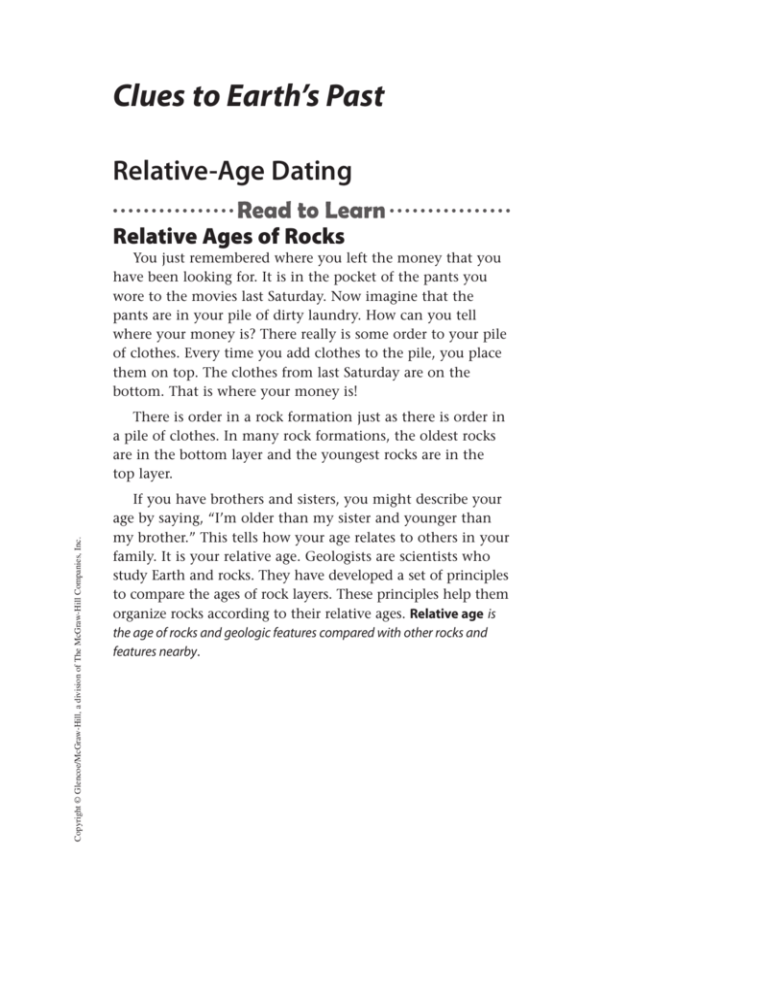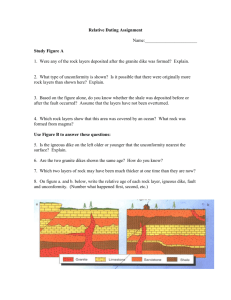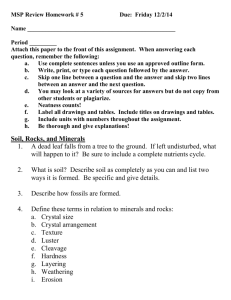Relative Ages of Rocks
advertisement

Clues to Earth’s Past Relative-Age Dating Relative Ages of Rocks You just remembered where you left the money that you have been looking for. It is in the pocket of the pants you wore to the movies last Saturday. Now imagine that the pants are in your pile of dirty laundry. How can you tell where your money is? There really is some order to your pile of clothes. Every time you add clothes to the pile, you place them on top. The clothes from last Saturday are on the bottom. That is where your money is! Copyright © Glencoe/McGraw-Hill, a division of The McGraw-Hill Companies, Inc. There is order in a rock formation just as there is order in a pile of clothes. In many rock formations, the oldest rocks are in the bottom layer and the youngest rocks are in the top layer. If you have brothers and sisters, you might describe your age by saying, “I’m older than my sister and younger than my brother.” This tells how your age relates to others in your family. It is your relative age. Geologists are scientists who study Earth and rocks. They have developed a set of principles to compare the ages of rock layers. These principles help them organize rocks according to their relative ages. Relative age is the age of rocks and geologic features compared with other rocks and features nearby. Superposition Your pile of dirty clothes demonstrates the first principle of relative-age dating—superposition. Superposition is the principle that in undisturbed rock layers, the oldest rocks are on the bottom. Forces do sometimes disturb rock layers after they are deposited. But if no disturbance takes place, each layer of rocks is younger than the layer below it. The principle of superposition is shown in the top part of the figure below. Layer 1 in the figure is the oldest rock layer, while layer 4 is the youngest. Original Horizontality The second principle of relative-age dating is called original horizontality. It is shown in the middle part of the figure below. Again, layer 1 is the oldest rock layer and layer 4 is the youngest. According to the principle of original horizontality, most rock-forming materials are deposited in horizontal layers. Sometimes rock layers are deformed or disturbed after they form. For example, the layers might be tilted or folded. When you see rocks that are tilted, remember that all layers were originally deposited horizontally. Lateral Continuity Superposition Original horizontality 4 3 2 1 4 3 2 1 Lateral continuity 4 3 2 1 4 3 2 1 Copyright © Glencoe/McGraw-Hill, a division of The McGraw-Hill Companies, Inc. Another principle of relative-age dating is that sediments are deposited in large, flat sheets. The sheets, or layers, continue in all lateral directions until they thin out or until they meet a barrier. This principle, shown in the bottom part of the figure below, is called the principle of lateral continuity. For example, a river might erode the layers, but the order of the layers does not change. Inclusions Sometimes, when rocks form, they contain pieces of other rocks. This can happen when part of an existing rock breaks off and falls into soft sediment or flowing magma. When the sediment or the magma becomes rock, the broken piece of rock becomes a part of it. A piece of an older rock that becomes part of a new rock is called an inclusion. According to the principle of inclusions, if one rock contains pieces of another rock, the rock containing the pieces is younger than the pieces. The first part of the figure below shows sediments deposited in layers that have become rock. The vertical intrusion shown in the middle part of the figure below is called a dike. The dike formed when magma flowed into the rock layers. The dike is younger than the pieces of rock, or inclusions, inside it. Fault Sedimentary rock layers Dike Inclusions Copyright © Glencoe/McGraw-Hill, a division of The McGraw-Hill Companies, Inc. 1 2 3 Cross-Cutting Relationships Sometimes forces within Earth cause rock formations to break, or fracture. When rocks move along a fracture line, the fracture is called a fault. According to the principle of cross-cutting relationships, if one geologic feature cuts across another feature, the feature that it cuts across is older. Notice in the figure above that both faults and dikes cut across existing rock. In the figure on the right, the fault cuts across rock layers and the dike. Scientists conclude that the dike is older than the fault because the fault is cutting across the dike. Both the fault and the dike are younger than the rock layers. Unconformities After rocks form, they are sometimes uplifted and exposed at Earth’s surface. As soon as rocks are exposed, wind and rain start to weather and erode them. These eroded areas represent a gap in the rock record. A Gap in Time Often, new rock layers are deposited on top of old, eroded rock layers. When this happens, an unconformity (un kun FOR muh tee) occurs. An unconformity is a surface where rock has eroded away, producing a break, or gap, in the rock record. An unconformity is not a hole or a space in the rock. It is a surface on a layer of eroded rocks with younger rocks on top. An unconformity does represent a gap in time. It could represent a few hundred years, a million years, or even billions of years. Types of Unconformities There are three major types of unconformities, as shown in the figure below. In a disconformity, younger sedimentary layers are deposited on top of older, horizontal sedimentary layers that have been eroded. In an angular unconformity, sedimentary layers are deposited on top of tilted or folded sedimentary layers that have been eroded. In a nonconformity, younger sedimentary layers are deposited on older igneous or metamorphic rock layers that have been eroded. Disconformity Younger sedimentary rock Disconformity ➞ Older sedimentary rock Unconformity Younger sedimentary rock Angular Unconformity ➞ Older sedimentary rock Nonconformity Younger sedimentary rock Nonconformity ➞ Older sedimentary rock Copyright © Glencoe/McGraw-Hill, a division of The McGraw-Hill Companies, Inc. Types of Unconformities Correlation Rock layers contain clues about Earth. Geologists use these clues to build a record of Earth’s geologic history. Many times the rock record is incomplete. For example, unconformities create gaps in the geologic record. Geologists fill in the gaps in the rock record by matching rock layers and fossils from separate locations. Matching rocks and fossils from separate locations is called correlation (kor uh LAY shun). Matching Rock Layers Another word for correlation is connection. Sometimes, geologists can connect rock layers simply by walking along rock formations and looking for similarities. Other times, soil might cover the rocks, or rocks might be eroded. When this happens, geologists correlate rocks by matching exposed rock layers in different locations. As shown in the figure below, geologists have used correlation to develop a historical record for part of the southwestern United States. Bryce Canyon National Park Copyright © Glencoe/McGraw-Hill, a division of The McGraw-Hill Companies, Inc. Utah Zion Bryce N.P. Canyon N.P. Grand Canyon N.P. Zion National Park Grand Canyon National Park Navajo sandstone Arizona Moenkopi formation Kaibab limestone 260 million years old Older rocks not exposed A B 190 million years old Carmel formation 230 million years old Older rocks not exposed C Index Fossils Some correlated rock formations are within a few hundred kilometers of one another, such as those in some national parks. They are correlated based on similarities in rock type, structure, and fossil evidence. If scientists want to learn the relative ages of rock formations that are very far apart or on different continents, they often use fossils. If two or more rock formations contain fossils of about the same age, scientists can infer that the formations are also about the same age. Not all fossils are useful in determining the relative ages of rock formations. Fossils of species that lived on Earth for hundreds of millions of years are not helpful. They represent time spans that are too long. The most useful fossils represent species such as certain trilobites. These trilobites existed for only a short time in many different areas on Earth. The fossils of these trilobites are index fossils. Index fossils represent species that existed on Earth for a short length of time, were abundant, and inhabited many locations. When an index fossil is found in rock layers at different locations, geologists can infer that the layers are of similar age. Trilobites, shown in the figure below, are examples of index fossils. Copyright © Glencoe/McGraw-Hill, a division of The McGraw-Hill Companies, Inc.






